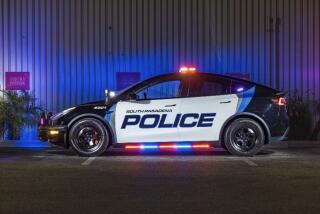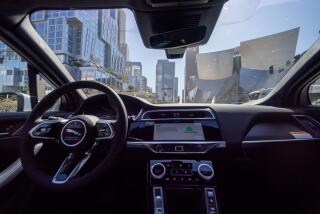(Almost actual size)
- Share via
When will Los Angeles get Smart?
Soon, says Steve Schneider, chief executive officer for Zap, the Santa Rosa company now selling Americanized versions of the adorable European nano-car. None too soon: Keebler elves everywhere are holding their tiny breaths.
Zap received the feds’ approval to sell the Smart coupe and cabrio in November but must wait for certification from the California Air Resources Board before selling them in this state and four Northeast states with similar emission standards.
“It’s just a matter of the application process,” said Schneider at an open house at Smart Auto LLC’s warehouse in Santa Ana last week. “We should have it in hand by June.”
That will give Angelenos looking to downsize from their Mini Coopers an option.
The Smart City Coupe -- a neon-colored iPod of personal mobility -- is small in a big way. Measuring a stumpy 8 feet long, the two-seat, ovoid runabout is 4 feet shorter than a Mini Cooper. It can actually park perpendicular to the curb -- at last, help for the parallel impaired. At less than 5 feet wide, it’s a half-foot narrower than the motorized minnow Chevrolet Aveo. And tipping the scales at 1,749 pounds, the Smart weighs only about a quarter what a Hummer H2 weighs.
But, on Los Angeles freeways, how smart is that?
“This car is very strong, very safe,” said Thomas Heidemann, president of Smart Auto LLC, which imports the car and modifies them for Zap to sell. The Smart, starting at about $15,000, comes with dual air bags, anti-lock brakes and electronic stability control as standard equipment. Built by DaimlerChrysler in France, the Smart car -- with what the company calls its “Tridion” safety cell structure -- survived brutal crash tests, one of which pitted the little car against a Mercedes-Benz S-class sedan. According to Heidemann, “The passengers in the Smart car came out better than the ones in the S-class.”
Volunteers? Anybody?
“If safety is your top priority, you shouldn’t be in a small car,” said Russ Rader, spokesman for the Insurance Institute for Highway Safety, an industry group that rates vehicles’ crash-worthiness. “In a crash with a heavier vehicle you are always at a disadvantage, regardless of how well the vehicle does in a crash test.”
As for buying insurance for the tiny cars, the news isn’t all bad. Insurance companies base their rates on the claims experience of a particular vehicle and index that data with the type of coverage: liability, medical payments, collision and comprehensive (theft, fire, weather damage and so on).
“It may be that one model generates more collision claims and less in liability,” said Dick Luedke, spokesman for State Farm Insurance, the nation’s largest auto insurance provider. For a car new to the market, the only guide is the sticker price of the vehicle. “For a new vehicle, that would be our starting point on collision and comprehensive coverage,” Luedke said. In other words, cheap cars are cheaper to insure. “For liability and medical, we would start them at a neutral level and then watch the data.”
To meet the demanding side-impact standard of U.S. crash tests, the Smart’s doors must be reinforced with aluminum cross beams. Yet, surprisingly -- since the U.S.-bound Smart power plant is an insky 698-cc turbocharged three-cylinder motor -- the EPA’s emission standards gave the engineers more trouble, requiring some re-plumbing of the engine intake and reprogramming of the engine management computer. It takes two to three weeks to convert the Smart into a U.S. street-legal automobile.
Magic wee folk are standing in line (or online at www.zapworld.com). Zap has a waiting list of more than 9,000 buyers nationwide and has taken more than $40 million in purchase orders from more than 50 dealers anxious to add the Smart to their showrooms, Schneider said. About a dozen dealers in California have Smartened up.
“I have 20 customers interested already,” said Ira Kreindel, owner of AutoHaus West in Irvine, which typically sells Ferraris and Porsches, cars slightly more powerful than the 61-horsepower Smart. Kreindel (an elvish nom-de-plume if ever I heard one) signed up to receive 150 Smart cars, and he might even take one home. “I own a Porsche 911 Turbo, but for the six miles I drive to work this car makes more sense.”
For hollow-tree-huggers, the Smart offers the best fuel economy of any non-hybrid car: 55 miles per gallon on the highway. The Honda Insight Hybrid gets 66 mpg on the highway, according to the EPA; the VW Golf/Jetta diesels get 47 mpg, but are not available in California.
“We saw the car in Europe and we were really impressed with it,” said Janine Saraf of Sierra Madre, who with her husband, Ted, came to Zap/Smart Auto’s open house. “We have six cars so we don’t need it, really. It’s just something to drive around in town.
“When nobody else has gas, we will,” Saraf said. “And besides, it’s cute.”
Did I mention it’s small?
Last week’s open house included parking lot test-drives with the U.S.-legal Smart, and I took one for a 1,000-yard test drive. Also, I have rented the cars in Paris, where they are bon, and in Germany, where they are nicht so schlecht. Smart cars are hilarious fun to drive in city traffic (Paris), being able to wend through openings in contentious traffic almost like a motorcycle. They are less fun on the Autobahn, where speeds hover around the 100 mph mark. While the car feels peppy enough around town, its 0-60 mph sprint of 15.5 seconds and top speed of about 85 mph may leave the car gasping to keep up with Vespas and ice cream trucks.
Zap’s Smart start-up takes place against the backdrop of, well, let’s call it size anxiety regarding small cars in the U.S. DaimlerChrysler recently froze plans to bring a larger Smart vehicle -- a bite-size SUV called the ForMore -- to the American market and only last week put off introduction of yet another premium subcompact called the B class. Other carmakers, buoyed by the success of the Mini and forecasting long-term discontent with fuel prices, are bringing demitasse premiums stateside, including the Audi A3 and the BMW 1. Nissan is rumored to be considering its Cube microcar for the American market. The question is, how small is too small?
“Vehicles like the Mini have shown that premium-priced vehicles from a strong brand, regardless of what size they are, are very appealing to people,” said Wes Brown, a consumer analyst with Iceology in Los Angeles.
Above all, Brown said, the Smart is a fashion statement. “It says that the owner is a little different, a little more European in their thinking, more cultured, more sophisticated ... more affluent is the impression.”
In fact, the Smart -- designed by the Swatch Group, makers of the boldly designed watches -- is loaded with style. Like the watches’ wristbands, the Smart’s body panels are interchangeable and come in bold metallic colors (such as “phat red” and “stream green”) and graphics. While the bare-bones models will sell for about $15,000, Smarts can be loaded to the gills with luxury-car options, including heated leather seats, moon roofs, navigation systems and more. A maxed-out Smart Cabriolet can cost $23,000, a price that would put it at a disadvantage against much larger, similarly equipped cars such as the Scion tC.
“As a value statement, it isn’t,” Brown said.
No matter, Brown said. “Trendsetters are willing to sacrifice certain things for having a vehicle that makes them feel so great about themselves and stands out so strongly.”
Automotive critic Dan Neil can be reached at dan.neil @latimes.com.
*
(BEGIN TEXT OF INFOBOX)
Smart City Coupe
Price: $15,000-$23,000
Powertrain: Rear-mounted inline three-cylinder, 698-cc (0.7-liter), all-aluminum, intercooled and turbocharged gas engine with electronic throttle control and dual spark plugs; six-speed sequential transmission with fully automatic mode; rear-wheel drive.
Horsepower: 61 at 5,250 rpm
Torque: 70 pound-feet at 2,000-4,500 rpm
Curb weight: 1,749 pounds
0-60 mph: 15.5 seconds
Top speed: 85 mph
Highway mileage: 55 miles per gallon (est.)
Range: 426 miles (est.)
Safety equipment: Stability control, anti-lock brakes, traction control, dual front air bags and optional side airbags.
Tires and wheels: 175/55 R15 (front) 195/50 R15 (rear); 5x15 inch (front), 6.5X15 inch (rear)
Maximum load: 572 pounds
Length: 96 inches
Wheelbase: 69.6 inches
Width: 58 inches
Height: 60 inches
Turning circle: 27.8 feet
Final thoughts: I am the Eggman, koo koo kachoo






